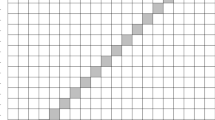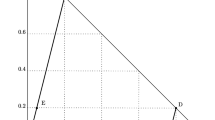Abstract
We study preference relations on conditional gambles of a decision maker acting under ambiguity. Dutch book rationality conditions are provided under a linear utility scale, encoding either an optimistic or a pessimistic attitude towards uncertainty. These conditions characterize possibly incomplete preferences representable by totally alternating or monotone conditional functionals. In general, the uniqueness of the representation is not guaranteed, but it can be obtained by adding the hypothesis of existence of a conditional fair price for every conditional gamble. The given rationality conditions have a betting scheme interpretation relying on “penalty fees” for betting on strict preference comparisons.
Similar content being viewed by others
References
Caldari, L., Coletti, G., Petturiti, D., & Vantaggi, B. (2016). Preferences on gambles representable by a choquet expected value with respect to conditional belief and plausibility functions. In J. Carvalho, M.-J. Lesot, U. Kaymak, S. Vieira, B. Bouchon-Meunier, & R. Yager (Eds.), Information processing and management of uncertainty in knowledge-based systems (pp. 569–580). Cham: Springer.
Capotorti, A., Coletti, G., & Vantaggi, B. (2014). Standard and nonstandard representability of positive uncertainty orderings. Kybernetika, 50(2), 189–215.
Chateauneuf, A. (1991). On the use of capacities in modeling uncertainty aversion and risk aversion. Journal of Mathematical Economics, 20(4), 343–369.
Chateauneuf, A. (1994). Modeling attitudes towards uncertainty and risk through the use of choquet integral. Annals of Operations Research, 52(1), 1–20.
Chateauneuf, A., & Jaffray, J. Y. (1989). Some characterizations of lower probabilities and other monotone capacities through the use of Möbius inversion. Mathematical Social Sciences, 17(3), 263–283.
Chateauneuf, A., Kast, R., & Lapied, A. (2001). Conditioning capacities and choquet integrals: The role of comonotony. Theory and Decision, 51(2), 367–386.
Coletti, G. (1990). Coherent qualitative probability. Journal of Mathematical Psychology, 34(3), 297–310.
Coletti, G., Petturiti, D., & Vantaggi, B. (2016). Conditional belief functions as lower envelopes of conditional probabilities in a finite setting. Information Sciences, 339, 64–84.
Coletti, G., Petturiti, D., & Vantaggi, B. (2018). Conditional submodular coherent risk measures. In J. Medina, M. Ojeda-Aciego, J. Verdegay, D. Pelta, I. Cabrera, B. Bouchon-Meunier, & R. Yager (Eds.), Information processing and management of uncertainty in knowledge-based systems. Theory and foundations (pp. 239–250). Berlin: Springer.
Coletti, G., Petturiti, D., & Vantaggi, B. (2019). Models for pessimistic or optimistic decisions under different uncertain scenarios. International Journal of Approximate Reasoning, 105, 305–326.
Coletti, G., & Scozzafava, R. (2001). From conditional events to conditional measures: A new axiomatic approach. Annals of Mathematics and Artificial Intelligence, 32(1), 373–392.
Coletti, G., & Scozzafava, R. (2002). Probabilistic logic in a coherent setting, trends in logic (Vol. 15). Dordrecht: Kluwer.
Coletti, G., & Scozzafava, R. (2006). Toward a general theory of conditional beliefs. International Journal of Intelligent Systems, 21(3), 229–259.
Coletti, G., Scozzafava, R., & Vantaggi, B. (2013). Inferential processes leading to possibility and necessity. Information Sciences, 245, 132–145.
Coletti, G., & Vantaggi, B. (2008). A view on conditional measures through local representability of binary relations. International Journal of Approximate Reasoning, 47(3), 268–283.
Császár, A. (1955). Sur la structure des espaces de probabilité conditionnelle. Acta Mathematica Academiae Scientiarum Hungarica, 6(3), 337–361.
de Finetti, B. (1937). La prèvision: Ses lois logiques, ses sources subjectives. Annales de l’Institut Henri Poincarè, 7, 1–68.
de Finetti, B. (1949). Sull’impostazione assiomatica del calcolo delle probabilità. Annali Triestini, 19(2a), 29–81.
de Finetti, B. (1950). Aggiunta alla nota sull’assiomatica della probabilità. Annali Triestini, 20(2a), 3–20.
de Finetti, B. (1975). Theory of probability 1–2. London: Wiley.
Dempster, A. (1967). Upper and lower probabilities induced by a multivalued mapping. The Annals of Mathematical Statistics, 38(2), 325–339.
Denneberg, D. (1994a). Conditioning (updating) non additive measures. Annals of Operations research, 52, 21–42.
Denneberg, D. (1994b). Non-additive measure and integral, theory and decision library: Series B (Vol. 27). Dordrecht: Kluwer.
Diecidue, E., & Maccheroni, F. (2003). Coherence without additivity. Journal of Mathematical Psychology, 47(2), 166–170.
Diecidue, E., & Wakker, P. (2002). Dutch books: Avoiding strategic and dynamic complications, and a comonotonic extension. Mathematical Social Sciences, 43(2), 135–149.
Dominiak, A. (2013). Iterated Choquet expectations: A possibility result. Economics Letters, 120(2), 155–159.
Driouchi, T., Trigeorgis, L., & So, R. (2018). Option implied ambiguity and its information content: Evidence from the subprime crisis. Annals of Operations Research, 262(2), 463–491.
Dubins, L. (1975). Finitely additive conditional probabilities, conglomerability and disintegrations. The Annals of Probability, 3(1), 89–99.
Eichberger, J., Grant, S., & Kelsey, D. (2007). Updating choquet beliefs. Journal of Mathematical Economics, 43(7), 888–899.
Ellsberg, D. (1961). Risk, ambiguity, and the savage axioms. The Quarterly Journal of Economics, 75(4), 643–669.
Epstein, L., & Breton, M. L. (1993). Dynamically consistent beliefs must be bayesian. Journal of Economic Theory, 61(1), 1–22.
Epstein, L., & Schneider, M. (2003). Recursive multiple-priors. Journal of Economic Theory, 113(1), 1–31.
Fagin, R., & Halpern, J. (1991). Uncertainty, belief, and probability. Computational Intelligence, 7(3), 160–173.
Gajdos, T., Tallon, J. M., & Vergnaud, J. C. (2004). Decision making with imprecise probabilistic information. Journal of Mathematical Economics, 40(6), 647–681.
Ghirardato, P. (2002). Revisiting savage in a conditional world. Economic Theory, 20(1), 83–92.
Gilboa, I., & Schmeidler, D. (1989). Maxmin expected utility with non-unique prior. Journal of Mathematical Economics, 18(2), 141–153.
Gilboa, I., & Schmeidler, D. (1993). Updating ambiguous beliefs. Journal of Econonomic Theory, 59, 33–49.
Gilboa, I., & Schmeidler, D. (1994). Additive representations of non-additive measures and the choquet integral. Annals of Operations Research, 52(1), 43–65.
Grabisch, M. (2016). Set functions, games and capacities in decision making. Theory and decision library C. Berlin: Springer.
Grabisch, M., & Labreuche, C. (2010). On using random relations to generate upper and lower probabilities. Annals of Operational Research, 175(1), 247–286.
Hanany, E., & Klibanoff, P. (2007). Updating preferences with multiple priors. Theoretical Economics, 2, 261–298.
Horie, M. (2006). A unified representation of conditioning rules for convex capacities. Economics Bulletin, 4(19), 1–6.
Horie, M. (2013). Reexamination on updating choquet beliefs. Journal of Mathematical Economics, 49(6), 467–470.
Jaffray, J. Y. (1989). Linear utility theory for belief functions. Operations Research Letters, 8(2), 107–112.
Jaffray, J. Y. (1992). Bayesian updating and belief functions. IEEE Transactions on Systems, Man, and Cybernetics, 22(2), 1144–1552.
Kast, R., Lapied, A., & Toquebeuf, P. (2012). Updating Choquet capacities: A general framework. Economics Bulletin, 32(2), 1495–1503.
Krauss, P. (1968). Representation of conditional probability measures on Boolean algebras. Acta Mathematica Hungarica, 19(3), 229–241.
Lapied, A., & Toquebeuf, P. (2013). A note on ’Re-examining the law of iterated expectations for Choquet decision makers’. Theory and Decision, 74, 439–445.
Mangasarian, O. (1994). Nonlinear programming. In Classics in applied mathematics, Vol. 10, SIAM.
Miranda, E., de Cooman, G., & Couso, I. (2005). Lower previsions induced by multi-valued mappings. Journal of Statistical Planning and Inference, 133(1), 173–197.
Rényi, A. (1955). On a new axiomatic theory of probability. Acta Mathematica Academiae Scientiarum Hungarica, 6(3), 285–335.
Riedel, F., Tallon, J. M., & Vergopoulos, V. (2018). Dynamically consistent preferences under imprecise probabilistic information. Journal of Mathematical Economics, 79, 117–124.
Schmeidler, D. (1986). Integral representation without additivity. Proceedings of the American Mathematical Society, 97(2), 255–261.
Schmeidler, D. (1989). Subjective probability and expected utility without additivity. Econometrica, 57(3), 571–587.
Shafer, G. (1976a). A mathematical theory of evidence. Princeton: Princeton University Press.
Shafer, G. (1976b). A theory of statistical evidence. In W. Harper & C. Hooker (Eds.), Foundations of probability theory, statistical inference, and statistical theories of science, The University of Western Ontario series in philosophy of science (Vol. 6b, pp. 365–436). Dordrecht: Springer.
Suppes, P., & Zanotti, M. (1977). On using random relations to generate upper and lower probabilities. Synthese, 36(4), 427–440.
Tallon, J. M., & Vergnaud, J. C. (2006). Knowledge, beliefs and economics. Beliefs and dynamic consistency (pp. 137–154). Cheltenham: Edward Elgar Publishing.
Vantaggi, B. (2010). Incomplete preferences on conditional random quantities: Representability by conditional previsions. Mathematical Social Sciences, 60(2), 104–112.
Wakker, P. (1998). Nonexpected utility as aversion of information. Journal of Behavioral Decision Making, 1, 169–175.
Walley, P. (1981). Coherent lower (and upper) probabilities. Technical report, Department of Statistics, University of Warwick.
Williams, P. (2007). Notes on conditional previsions. International Journal of Approximate Reasoning, 44(3), 366–383.
Acknowledgements
We thank the anonymous reviewers for their very detailed and constructive suggestions. The authors are members of the INdAM-GNAMPA research group. This work was partially supported by the University of Perugia, funding of 2015 Research Projects under grant “Decisions under risk, uncertainty and imprecision”, La Sapienza University of Rome funding of 2015 under Grant C26A15Y4EZ “Numerical and probabilistic models for the management of information”, the Italian Ministry of Health under Grant J521I14001640001 “Intelligent systems helping in decisions for the early alert and the dissuasion to the use of doping”.
Author information
Authors and Affiliations
Corresponding author
Additional information
Publisher's Note
Springer Nature remains neutral with regard to jurisdictional claims in published maps and institutional affiliations.
Rights and permissions
About this article
Cite this article
Coletti, G., Petturiti, D. & Vantaggi, B. Dutch book rationality conditions for conditional preferences under ambiguity. Ann Oper Res 279, 115–150 (2019). https://doi.org/10.1007/s10479-019-03299-8
Published:
Issue Date:
DOI: https://doi.org/10.1007/s10479-019-03299-8




